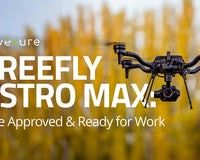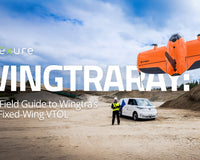DJI Enterprise has consistently raised the bar for enterprise drones, delivering reliable and cost effective tools for professionals in public safety, infrastructure inspections, and surveying. With the recent release of the DJI Matrice 400 (M400), DJI introduces significant upgrades that promise enhanced flight performance, greater payload versatility, and cutting-edge safety features.
Still, with the Matrice 350 RTK widely respected as a reliable workhorse—and many continuing to operate the Matrice 300—end-users are asking: Is upgrading to the M400 worth it?
In this blog, we'll break down the key differences between the Matrice 400, Matrice 350, and Matrice 300. We'll look closely at flight capabilities, payload flexibility, video transmission, AI features, battery performance, and practical applications across key industries.
By the end, we hope you can make a confident and informed decision on whether the DJI Matrice 400 is the right fit for your organization or department.
Flight Performance: Time & Speed
One of the more clear-cut improvements in the DJI M400 is its enhanced flight performance. With a maximum flight time of 59 minutes, the M400 surpasses the 55-minute flight duration on both the M350 and M300. This additional endurance can enhance operational efficiency, allowing drone operators to cover larger areas and complete longer missions with fewer battery swaps.
Additionally, M400 boasts a top horizontal flight speed of approximately 56 mph (25 m/s), an improvement over the 51 mph (23 m/s) of the M350 and M300. This increased speed can be critical in time-sensitive applications such as emergency response, and search and rescue operations, enabling teams to reach critical locations faster and improve overall response time.
| Specification | Matrice 400 | Matrice 350 RTK | Matrice 300 RTK |
|---|---|---|---|
| Max Flight Time | 59 min | 55 min | 55 min |
| Max Horizontal Flight Speed | 56 mph (25 m/s) | 51 mph (23 m/s) | 51 mph (23 m/s) |
Payload Capacity & Flexibility
Payload capacity and flexibility are important considerations enabling drone pilots to efficiently adapt to diverse mission requirements. The M400 notably excels in this area, supporting a maximum payload of 6 kg (13.2 lbs)—more than doubling the 2.7 kg payload capacity of the M350.
In addition to increased payload capacity, the Matrice 400 can simultaneously support up to seven payloads, significantly enhancing operational versatility. This capability allows users to quickly switch between inspection, mapping, search-and-rescue, and tactical missions without time-consuming payload changes, providing substantial improvements in mission readiness and operational efficiency.
| Specification | Matrice 400 | Matrice 350 RTK | Matrice 300 RTK |
| Max Payload Weight | 6 kg (13.2 lbs) | 2.7 kg (5.9 lbs) | 2.7 kg (6 lbs) |
| Max Simultaneous Payloads | 7 | 3 | 3 |
Payload Compatibility
Here’s a table highlighting key DJI payloads supported by each Matrice model:
| Payload | Matrice 400 | Matrice 350 RTK | Matrice 300 RTK |
| Zenmuse H30/H30T | ✅ | ✅ | ❌ |
| Zenmuse H20/H20T | ❌ | ✅ | ✅ |
| Zenmuse L2 | ✅ | ✅ | ❌ |
| Zenmuse L1 | ❌ | ✅ | ✅ |
| Zenmuse P1 | ✅ | ✅ | ✅ |
| Zenmuse XT2/Z30 | ❌ | ✅ | ✅ |
| Zenmuse S1 Spotlight | ✅ | ❌ | ❌ |
| Zenmuse V1 Speaker | ✅ | ❌ | ❌ |
| Manifold 3 | ✅ | ❌ | ❌ |
Obstacle Avoidance & Safety Systems
Safety and reliability are paramount for any drone operation, especially in complex or hazardous environments. The M400 introduces an advanced obstacle avoidance system that significantly enhances safety and operational confidence. Key features include a rotating LiDAR system, mmWave radar, and full-color low-light vision.
This comprehensive sensing suite enables the Matrice 400 to detect and avoid obstacles even in challenging conditions such as darkness, fog, or dust.
| Obstacle Sensing Features | Matrice 400 | Matrice 350 RTK |
| Rotating LiDAR | ✅ (360° scanning, power-line detection) | ❌ |
| mmWave Radar | ✅ | ❌ |
| Full-Color Low-Light Vision | ✅ | ❌ (Standard IR) |
Transmission System & Range
Reliable and robust communication is critical for drone operations in remote or obstructed environments. The M400 features DJI's new O4 Enterprise Enhanced transmission system, offering significant improvements in range and video quality compared to the O3 system for the M350.
The M400 provides an impressive maximum transmission distance of 24.8 miles (40 km, FCC compliant), nearly doubling the M350’s maximum range of 12.4 miles (20 km, FCC compliant). Furthermore, the M400 supports 1080p video at 60 frames per second, enhancing live video clarity and situational awareness during critical missions.
Also worth mentioning is the Matrice 400's Airborne Relay feature, enabling one drone to relay signals to another, significantly extending operational range and improving mission flexibility in challenging terrain or complex urban environments.
| Transmission System Features | Matrice 400 (O4) | Matrice 350 RTK (O3) |
| Max Transmission Distance | 24.8 mi (40 km, FCC) | 12.4 mi (20 km, FCC) |
| Video Transmission Quality | 1080p/60fps | 1080p/30fps |
| Airborne Relay | ✅ | ❌ |
These enhancements are particularly beneficial for extended BVLOS operations and critical missions requiring uninterrupted, high-quality video feeds.
Intelligent AI & Autonomous Capabilities
The Matrice 400 introduces advanced intelligent AI features and autonomous capabilities, enhancing operational efficiency and reducing a pilot's mental workload.
These next-gen capabilities include Smart AI Detection of people, vehicles, and vessels, real-time AR projection for power lines and maps, terrain-following capability, as well maritime takeoff and landing.
| Intelligent Features | Matrice 400 | Matrice 350 RTK |
| Smart AI Detection | ✅ | ❌ |
| AR Projection | ✅ | ❌ |
| Real-Time Terrain Follow | ✅ | ❌ |
| Maritime Landing & Takeoff | ✅ | ❌ |
| Cruise, FlyTo, POI Modes | ✅ | ❌ |
| Smart 3D Capture | ✅ | ❌ |
| Slope & Geometric Route Planning | ✅ | ❌ |
Industry Use Cases
The Matrice 400 excels across various demanding applications, offering specific benefits for critical industry use cases:
-
Public Safety (Police, Fire, SAR): Enhanced flight speed and AI detection for rapid deployment and comprehensive scene analysis.
-
Infrastructure Inspections: Increased payload flexibility and advanced obstacle avoidance for safer, more detailed inspections.
-
Surveying & Geospatial Mapping: Extended flight endurance and improved payload compatibility for large-scale mapping and surveying operations.
-
Offshore & Maritime Operations: Specialized maritime landing and takeoff capabilities, essential for challenging offshore environments.
-
Forestry & Environmental Management: Robust obstacle avoidance and terrain-following capabilities for precise and safe operations in complex terrain.
Should You Upgrade?
Deciding whether to upgrade to the DJI Matrice 400 involves careful consideration of your specific operational needs, mission requirements, and budget constraints. For organizations that need maximum payload versatility, longer flight times, Smart AI features, and the flexibility of landing and takeoff on ships, the M400 is a worthwhile investment.
However, for operations with less demanding requirements or tighter budget constraints, the Matrice 350 RTK remains an incredibly capable drone that continues to deliver reliable performance. Ultimately, your choice should align closely with your operational objectives, mission complexity, and the long-term strategic value an upgrade would provide your organization.
For additional guidance on how to integrate UAS to your operations, we’re here to help! Our Enterprise team can provide expert guidance on platform selection, integration, and accessories tailored to your organization’s needs. Contact us today to learn more or request a quote.










